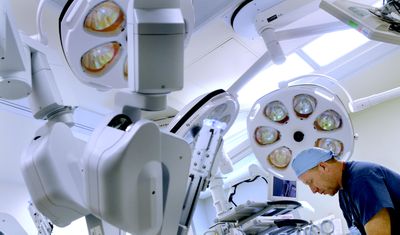Operating masterpiece
KMC’s new robot, called da Vinci, lends doctors a hand in some surgeries

Perching over a patient on the operating table is becoming less common for Dr. Ted Ellison.
At least physically anyway as Ellison is one of five Kootenai Medical Center surgeons trained to use a state-of-the-art robot for certain minimally invasive surgeries. The da Vinci machine, a $1.65 million addition since April to the hospital’s surgical robotics program, has been lending a surgically assisted hand to the physicians in performing prostate and urological procedures, such as removing tumors, diseased kidneys and cancerous prostate glands, as well as certain surgeries in women, including hysterectomies.
“This technology is part of a push to be less invasive. … All surgery is getting less invasive, but this is an exceptional way that we can do more surgery less invasively,” said Ellison, a urologist, while standing in the Kootenai Heart Center lobby in between surgeries during a recent open house showcasing the da Vinci, which allowed the public a hands-on opportunity to learn more about the machine and its surgical advantages. “It’s intuitive, it works. What I have found is that, when you learn to use this equipment, you suddenly say ‘Wow, you can almost do anything.’ ”
The machine consists of three separate components linked through fiber-optic cables: the patient cart, which has three interchangeable instrument arms and another limb attached with two high-definition cameras; a tower that houses monitors and an external TV; and the main console.
Sitting at the console across the room, the surgeon peers through a viewer that combines the two camera feeds into a true 3D picture capable of up to a 10X zoom, while underneath, their fingers loop into grasping devices linked to the nearby patient cart’s robotic arms. The operator can switch between arms and manipulate the cameras on the fly using foot pedals. Inside the patient, the robotic arms are able to precisely mimic the slightest hand movement, such as rolling the wrist and tying sutures, while eliminating any hand tremors made by the surgeon on the other side of the room.
“It gives you that internal wrist,” Ellison said, adding that the robot has been used primarily for urology procedures.
So instead of an open surgery, which often requires a six- to nine-inch incision for a surgeon’s hands, or previous laproscopic machines, which lacked the micromovement sensors and ability to see around corners, the da Vinci robot needs only about a centimeter wide cut without slicing through muscle. The advantages include less pain, less scarring, a faster recovery (in as little as a one-day stay at the hospital), lowered risk for infection, and most importantly; less blood loss, said Jonathon Steinbach, a clinical sales representative from Intuitive Surgical equipment, which invented the machine, on-hand at the open house.
“It’s also better for the hospital economically because they can empty a bed in a day,” he added.
Originally developed more than 10 years ago with heart surgery in-mind, Steinbach said the da Vinci has instead revolutionized prostatectomy procedures. “Intuitive aimed for the heart but hit the prostate,” he said about the robot.
Currently there are more than 700 of the machines in-use across the U.S. – two of which are at Sacred Heart Medical Center in Spokane – and another 300 overseas.
KMC’s addition is the second for Idaho, with the first in Boise. The da Vinci has even been used in a remote procedure where the surgeon was in a different country than the patient, although that isn’t the company’s focus, Steinbach explained.
“The future is here,” he said.
For example, he offered the fact that 63 percent of prostectomies in 2007 were done robotically, and that number is increasing. The da Vinci has similar potential with hysterectomies, Steinbach said, since the majority of those procedures were done last year in open operations, leaving a long scar on the patient’s abdomen. Heart surgery is also a future possibility, he added, which would allow the surgeon to pass through the ribs instead of splitting open the chest.
If recent patient feedback is any indication, the robot has many promising future applications. And for those patients, the side effects are felt well beyond the operating room, said Kim Anderson, a KMC spokeswoman.
“The feedback that I have heard is mostly from patients – they love it,” she said in the lobby, while a visitor practiced using the robot on a training table with rubber bands and a dime they could pick up and manipulate. “When you see how it really changes people’s lives, that’s what’s important.”